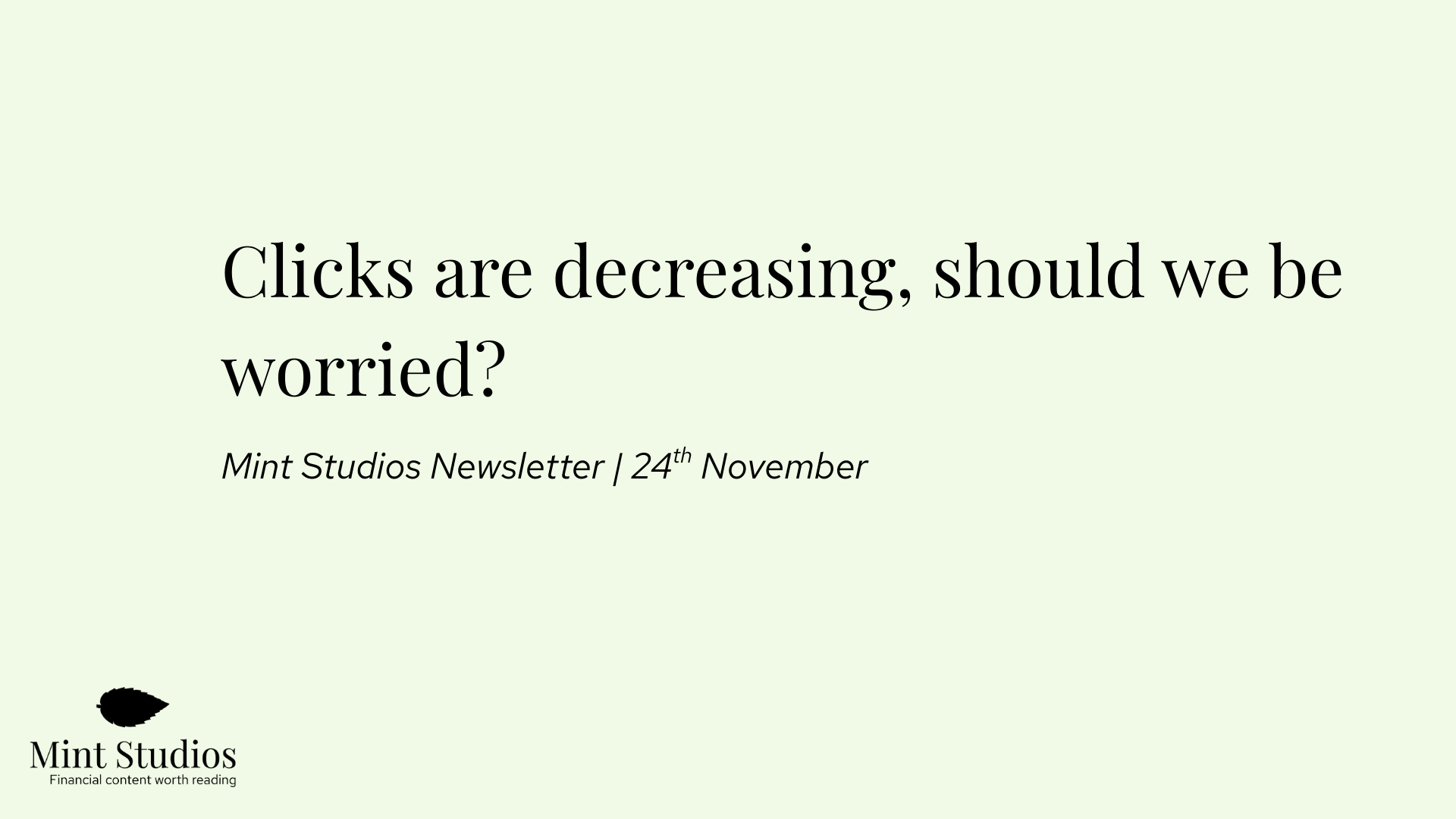The foundation of great content is great research.
Just like building a product, creating great content that speaks to your audience only happens when you have a good grasp of what your audience wants to read.
And yet, too many people base their content strategies on high keyword search volume, low to high competition and regurgitated content that already exists on Google.
That type of content might get you traffic, but it won’t get you customers and leads — which, at the end of the day, is what your business really needs.
At Mint Studios, we base our content strategy on customer pain points: understanding what makes a searcher go online and start researching solutions to their problems. But in order to do that properly, we need to first understand your customer pain points.
In this article, we break down how we do this research step by step.
What is the objective of this exercise?
Understanding customer pain points is a big part of doing this research. If your product is very new, then your next job is to do the required customer research to understand your customer pain points. These books are a good place to start if you’re learning how to do customer research:
In the context of content marketing, the ultimate objective of completing this customer research is to come out with a long list of pain points and triggers of your target market.
Once that research is done, only then do you do keyword research to try and understand what specific words they use to find solutions, and therefore what type of content to create.
How do you do the research?
In an ideal world, you would directly interview your customers. Meaning, you would sit down with your existing customers and prospects and ask specific questions to understand their pain points and what kind of content they currently consume.
But this isn’t always possible, either for legal reasons, practical reasons or company reasons.
In that case, the second best option is to chat with certain people on your team — ideally, those that are the most customer facing. At Mint Studios, we usually like to talk with:
- Head of Sales
- Head of Product
- Customer service
- Head of Marketing
- Founder
If you can, set up calls with the right people and ask them questions on what they know about your customers.
How to set up the interviews
We like to have a specific set of questions ready when we get into an interview, but there are a few best practices:
Best practices when doing customer research interviews:
- Always have a list of questions ready to ask when going into the call, but make sure to allow for spontaneity
- When something interesting comes up, make sure to follow up on the thread. That’s often where you find hidden pain points that aren’t talked about much (and therefore a competitor would never think of).
- Always ask why, and don’t be scared to dive deeper
- Always record the calls
- Gather all marketing and research material as possible. Any slide decks, customer research, product roadmaps, etc
The objective is to get as deep as possible. Ask yourself:
- Why is the reader in pain?
- What are they struggling with?
- What do they wish they had?
- What triggers them to look for a solution online?
Here are some of the types of questions we like to ask each person:
Questions to ask the founder
If possible, always try to chat to the founder. They’ll give you the best overview of the product and company.
- What is your story? Why did you start?
- How is the product different to others? What are the differentiators? What is your competitive advantage? (and we also do a product demo)
- Who are your best customers (those that spend the most and stay the longest)
- What are their pain points?
- What are the most popular use cases?
- Real examples of pain points
Questions to ask the sales team
The sales team is one of the most valuable assets a company has. As the content person, your sales team will offer you insights into what your customers are asking, what their problems are and how they’re looking for solutions. Since they’re talking to customers every day, they are on the ground and know what is and isn’t working.
Some questions to ask:
- What was the last prospect/company that you had a really easy time closing? What type of prospects are the ones that are the easiest to close?
- What are you usually compared to? What are the alternatives?
- What is the most common reason for buying your product?
- How do they currently solve X and how much does it cost to do so?
- What happened last time their problem came up? What did they do?
- What are the pain points that you keep seeing?
- What are the most common use cases for using the product?
- What would you say is your biggest competitive advantage?
- Is it possible for prospects to solve their problems without X? How?
- Real examples
Questions to ask the customer service team
- What are some of the top questions that you get asked on customer phone calls?
- What type of content would stop you from continuously repeating the same answers?
- Who are your best customers?
- What are the most common use cases for using your product?
- What are the most popular features of your product?
- Real examples
Questions to ask the product team (or anyone else):
- What are the most popular features?
- Have prospects referenced a specific piece of content before?
- Talk to me about the recent conversation you had with a prospect. What was their challenge? How did they go about solving it?
- What question should people ask you, but don’t?
- What are the most important things that our audience should know before using X
- What are some tools they use every day? What is the best way to use them?
- What are some unexpected benefits or side effects of using X?
- Real examples
The interviews are done, now what?
1. Make a list of pain points
After doing the interviews, you should have a good understanding of what makes your target audience tick, what keeps them up at night and what questions they’re asking.
But it can be a lot of information, so it’s best to go bit by bit. Since you have the recordings of the calls, the next step is to transcribe them using something easy like Otter.
Once we have the transcripts, we like to comb through the recordings and look for pain points or questions that keep coming up. We keep this part simple: set up a spreadsheet or doc, and then go through each transcript, looking for pain points and content ideas.
We often end up with 30+ pain points! Not all can be turned into content and not all will apply. But the more you end up with the better.
2. Categorise pain points
Once we have a list of pain points, we like to separate between barriers and pains, and drivers and delights. You can even do a WHaLP assessment, by asking questions like:
- What do they want?
- What do they hate?
- What are they lacking?
- What kind of problems motivated them?
This usually involves setting up separate columns, once again on a spreadsheet, and allocating the phrases you’ve heard into the right sections.
3. Do some keyword research
Only now should you start using the phrase “keyword research”. Keyword research shouldn’t drive a content strategy or customer research. It’s about understanding the specific words your target audience is using when they search for a solution to their problem online.
Although your target market’s pain point might be “Investment platforms have high fees”, the right keyword might be “investment app no fees”. If you’re building an invoice solution for freelancers, it might be worth creating unique content for “create invoice sole trader” as well as “create invoice freelancer”.
This is the most difficult part of the content strategy, and arguably the one where people would say content becomes “art”. This is the part where you’re really putting yourself in the shoes of the target market, and trying to find the words they use to research their problems and solutions.
Since it has a lot to do with intuition and understanding the customer, that’s why it’s even more important to do this exercise after doing your customer research and understanding pain points. Someone who hasn’t done this research and only does keyword research, doesn’t really know what to look for and will just end up with generic Top of the Funnel content that doesn’t really appeal to their target audience.
4. Prioritise by strongest intent
You’ll hopefully end up with 50+ keywords that you’ve found through a mix of using SEO tools, the “People also Ask” section on search results and the Google results themselves.
What’s next? Creating a strategy and calendar, and deciding what type of content to create. We use the Mint Studios Framework, which means we start by creating the content that targets those customers that are ready to convert — also known as Bottom of the Funnel.
Our argument is that those who already know they have a problem and know what the solution is are your best customers and the low hanging fruit. While others might begin by creating Top of the Funnel content, we argue it’s better to start with Bottom of the Funnel.
So if we had to choose between “investment app no fees” and “benefits of using an investment app”, we might pick the first one since it highlights a stronger pain and someone searching this might be closer to converting.
Not every single pain point has to be connected to a keyword — many won’t have a perfect phrase that has 100+ searches per month. If you know the pain point is a big one and you get the question a lot, then go ahead and create it. Not everything has to be dictated by SEO and keyword research.
5. Putting together a strategy
People seem to be confused about what a strategy is, ending up with a document that lists out stuff like “mission” “vision”, “values”, etc. That is not a strategy.
A strategy involves evaluating the competitive landscape, identifying your competitive advantages and then figuring out how to use your competitive advantage to make the most of an opportunity.
For example, based on your pain point and keyword research, you can decide to focus on one very specific feature that you know puts you above the rest. If you see that none of your competitors are writing about X and you know X is a big pain point that you can solve for, then it might be worth prioritising that piece of content.
For example, we have a client in a very competitive space. So we decided to create BOFU content that highlights and focuses on the one competitive advantage they have over competitors.
For another client that isn’t in a competitive space, we’re using the first-mover advantage to go straight for the high-intent, BOFU keywords.
The core of our strategy remains the same: focus on Bottom of the Funnel and attracting our best customers. But we also add another layer that helps us make it even more focused on the product, market and customers. That’s why every 3 months we like to revise the strategy based on findings. We might decide to focus on a different product feature, or a different distribution channel.
We find that 3 months gives you enough time to see results, but is short enough that you can keep changing.
6. Executing
Execution is the hardest part. Sure, without a strategy you’ll probably end up wasting a lot of time and money. But without execution, nothing happens.
And there is a lot that is involved in making content, including:
- Interviewing Subject Matter Experts
- Writing an article outline
- Writing several drafts of an article
- Editing and proofreading
- Publishing on your CMS
- Ensuring your content is compliant
- Optimising for conversions
- Promoting via social media or ads
- And more!
That’s why we’re a full service agency that takes care of everything from start to finish. The fact is, you really need a small team in order to execute content correctly.
If you don’t have the budget to work with an agency or to hire people in content, you can still do content at a smaller scale. Once you’ve done the research outlined above, you’ll have a good idea of what pain points and frequent questions your customers have. Forget keyword research and all the rest, and start creating content that addresses those key pains, questions and triggers your audience has. That way, at least you know you’re creating content that people will actually want to read.
Great content comes from in-depth research
To finish this off: great content must be based on understanding your customers inside out. If not, you’re not creating content for your customers – you’re creating it for beginners, or people who won’t ever sign up. A good sign of this being the case is if you’re embarrassed by your content. If that’s the case, then it’s not a good sign, and it means it’s time to do some real research for your content.
Hopefully this article gives you a bit of an overview of how to do research for your content marketing efforts. Any questions about customer research, content marketing and financial services, feel free to send us an email. We’re always happy to chat and share our thoughts.











